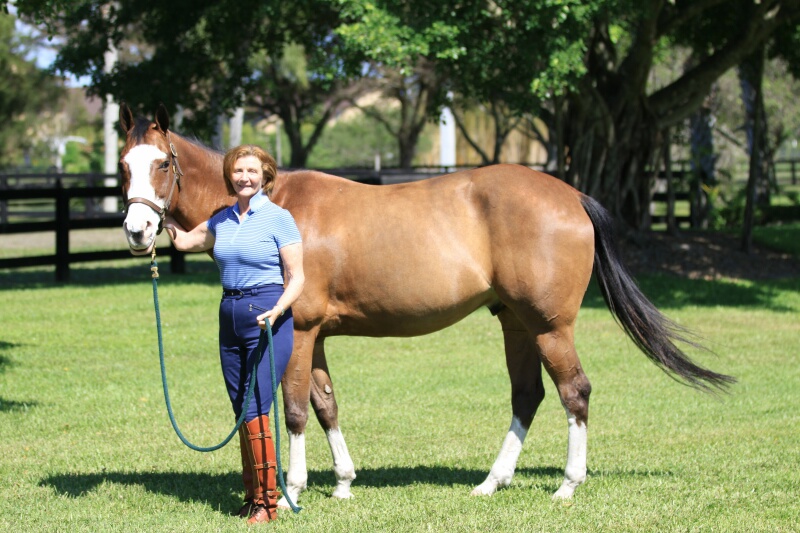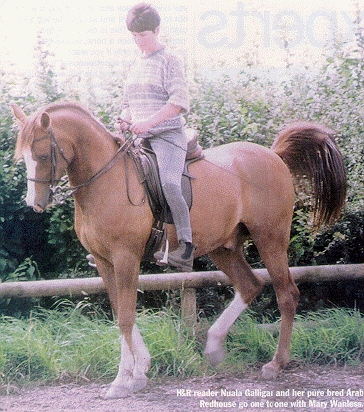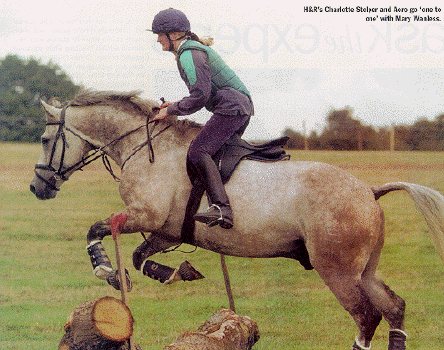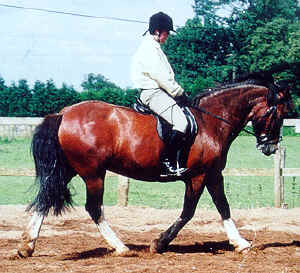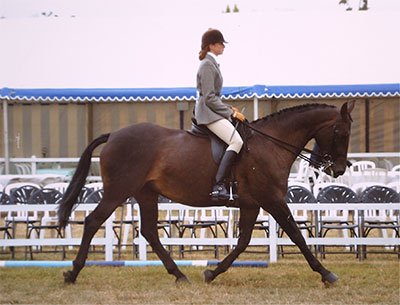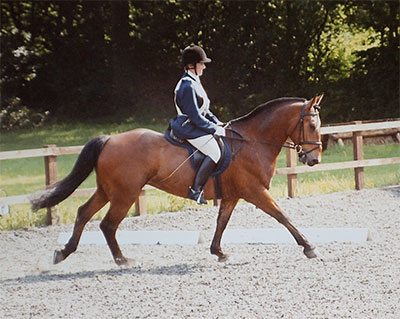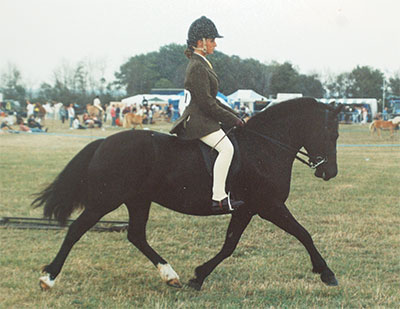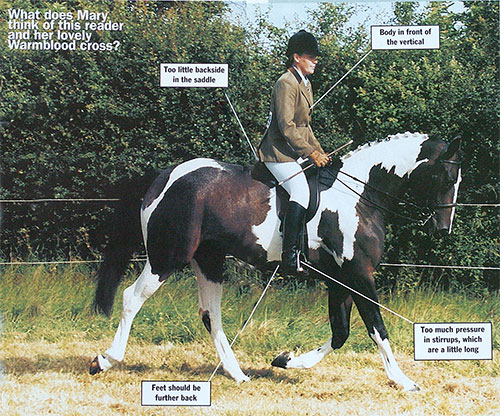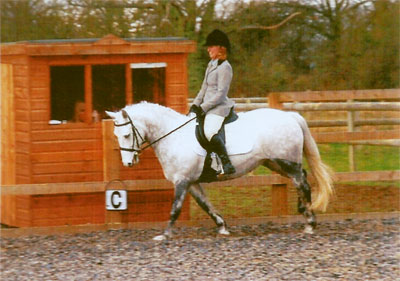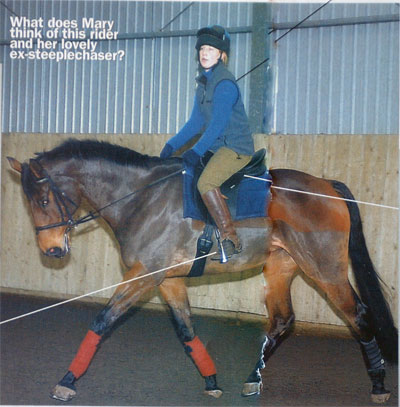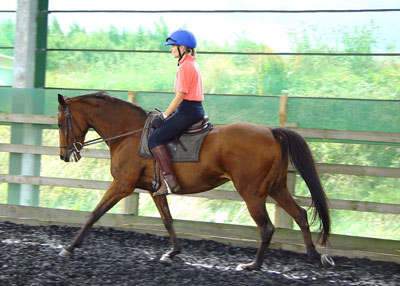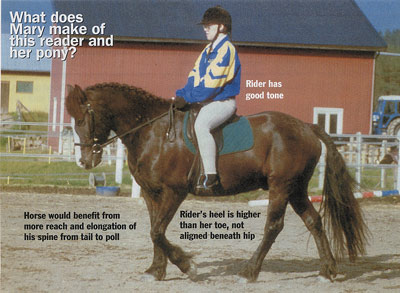RWYM
ARTICLE 25
 This photograph shows a fourteen year old girl riding a rather handsome five year old, who has done some schooling and Pony Club activities. He has apparently improved a lot from a rather fizzy and whizzy beginning which left our rider somewhat unnerved. But a lot is happening right here, suggesting that she managed to hold herself together and develop enough basic skills to turn the situation around. Good for her!
This photograph shows a fourteen year old girl riding a rather handsome five year old, who has done some schooling and Pony Club activities. He has apparently improved a lot from a rather fizzy and whizzy beginning which left our rider somewhat unnerved. But a lot is happening right here, suggesting that she managed to hold herself together and develop enough basic skills to turn the situation around. Good for her!
She is shown here in sitting trot, and the horse is beginning to reach into the rein, showing a nice unbroken curve from wither to poll. His nose appears to be just in front of vertical, although he would ideally have a more open angle between the underside of his jaw and his neck (see last month’s picture for comparison). This would demonstrate to us that the rider is absolutely not holding the horses’s head down, or restricting him in any way. When her rider biomechanics are so good that she trusts her thigh and torso to draw his back up, she can allow him the freedom to place his neck as he chooses – and he would choose to place his ears a bit lower down and further away from her front. This would be more fitting for the carriage of the rest of his body, for he is not collected enough to have his head this high.
Notice that there is more bulk and length of horse behind the rider than there is in front of the rider. This difference between the back and the front of the horse can be much more profound than one sees here, but it is still a give-away sign that the horse needs a more genuine reach into the rein. His forehand would then elongate and fill out, as if he were a stuffed toy horse that was even more full of stuffing. Notice too that his tail is not quite so well carried as it might be. But despite these signs that he is not yet moving as freely as he could, he appears to have a very strong back that forms a substantial bridge between his forehand and this quarters.
I find that the phrase ‘swinging through his back’ often misleads riders into thinking that the horse’s back should feel very mobile, or like a soft feather bed. On the contrary it should feel solidly there, and I often think of each of the long back muscles (that lie beneath the panels of the saddle) like a piece of the conveyor belt rubber that you see at the supermarket checkout. Metaphorically speaking, the horse whose back does not form a bridge between his quarters and his forehand can feel as if his back muscles are soggy elastic bands that are not under tension. But the horse in our picture is ‘connected’, and one does not get the feeling that there are any ‘soggy’ or missing bits in his topline. He is ‘all of a piece’, and this is a good sign.
In this phase of the stride we can see that his hind foot is stepping just behind the foot print left by the forefoot. He is close to tracking up (in which it steps into that footprint), but is not quite active enough to show us this text book ideal. However, the three spaces between his legs form even equilateral triangles, and this too is an extremely good sign. Often the horse’s hind leg is more behind his quarters than his foreleg is in front of his shoulder, and this is the classic signature of a horse on his forehand. The horse who shows us that silhouette cannot hold himself up without leaning on the rider’s hand, but this guy does not need to use the reins as a prop.
It is interesting to note, however, that a significant length of the mouthpiece of the bit is showing to the inside of his mouth. Notice too that the rider’s inside hand is behind her outside hand. These two facts are related, and we will consider them in more detail later.
The rider probably has her stirrups a little short, since the line of her thighbone (which would bisect her thigh) is more horizontal than forty-five degrees. Kids and teenagers often out-grow their correct stirrup length without anyone realising, and it is time for our rider to go down a hole. Many trainers would still consider that to be too short; but I maintain that she should emulate the top dressage riders of the world, most of whom show the forty five degree line. This is an important element of good rider biomechanics. It gives the thigh maximum leverage as it draws up the horse’s back.
What I like best about this photograph is the expression of focussed attention on both the rider’s and the horse’s faces. The horse has his ears out sideways, which implies that his attention is directed inward and onto his rider. He is certainly not ‘spaced out’ or gazing at the view. Both he and the rider are absorbed in their work, and whilst the rider’s face does not show any angst, it is clear to me that her brain cells are ticking away as she attempts to solve the problems posed by riding.
This quality of attention is a tremendous achievement in one so young, especially given that she is working in for a test and is riding a horse who has been difficult. As we all know, both warm up and competition arenas are the hardest places in the world to stay centred and maintain your focus! In lessons I very often have to teach people how to concentrate, paying attention in each moment to changes in their own body and their horse’s body. This is the secret of feel, and it is a learnable skill – especially once you know what changes you should be paying attention to (and this is not obvious). Furthermore, since concentration is the ‘master art’ that opens the door to learning any skill you want to name, it is the greatest gift that I can give my students – not that I can give it; but I can certainly help them find it.
So the first task that faces our rider is learning how to elongate the horse’s frame even more, and it may even be that just giving her hand forward would do the trick. For her rider biomechanics are working quite well. To have more power in her torso and thus less restriction in her hand she needs to bear down more (using her stomach muscles as you do when you clear your throat) and to use her thighs as more effective levers. This would spread her weight down through her thigh, making her sit more as if she were on one of those ‘kneeling stools’, where both the shins and the underside of the thighs rest on a slope. That in turn would give our rider a better hip to heel vertical line, for her lower leg is more forward than it should be. There is another factor at play here too, for her leg position is also being influenced by her asymmetry.
As she improves her rider biomechanics, her biggest long term challenge is going to lie in working with this, for her body is twisted to the left, putting her left hand behind her right, and creating the stronger contact that pulls the bit through the horse’s mouth. This picture is not taken from the ideal vantage point of the centre of the rider’s circle, from which the twist will, I think, look even more profound., and her lower leg even more out of position.
The horse has reacted to it less strongly than he might have done, for often it will cause him to jack-knife, and fall out profoundly through his outside shoulder. But whilst many people might think that this horse is showing us a nice bend, it is clear to me that the rider is having difficulty making the turn – notice how her outside hand is actually crossing his neck. This is a desperation measure that creeps in when pulling on the inside rein does not work; but the fix that will work has to involve her whole torso, and in particular her outside seat bone and shoulder.
With both her pelvis and shoulders twisted to the inside, the rider may well have lost her outside seat bone. It will have advanced, and possibly lifted, tilting her so that her chin comes to the inside. (It is hard to know from the photograph if this has happened, but I suspect that it has.) It is no mean achievement to keep your spine dead on vertical, especially on the more difficult rein, and as you ride it can pay to glance down and ask yourself ‘ Is my chin directly over his mane, or is it off to one side?’ You will make and maintain the correction much more effectively if you think of keeping your outside seat bone far back and close to the horse’s spine. Aim to have equal weight on both seat bone – an important tenet of good rider biomechanics – and keep ‘checking in’ to find out if this is still the case.
That outside seat bone initiates the turn, and as soon as it goes missing you will pull on the inside rein, for this is the default option. When you are positioned well, you will probably feel that you are facing to the outside of the circle, for your outside shoulder must stay back in order to pin your outside seat bone in place. Most people find this very disconcerting, but when you discover how effective your turning aids are when you deliver them from ‘fencing lunge position’, you will know that this is the answer to your problems. Your horse will make it very clear to you, reinforcing your faith in the good rider biomechanics that are the backbone of skill.
Meanwhile, I wish our rider well, and hope that she can begin to unravel this twist. I commend her for all that she has learnt so far, and would love to see her build on her strengths. She has a lot going for her, and has a lovely horse to learn on.

